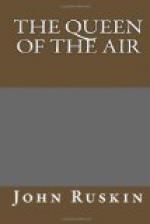144. I said, a little while ago, that the practical teaching of the masters of Art was summed by the O of Giotto. “You may judge my masterhood of craft,” Giotto tells us, “by seeing that I can draw a circle unerringly.” And we may safely believe him, understanding him to mean that, though more may be necessary to an artist than such a power, at least this power is necessary. The qualities of hand and eye needful to do this are the first conditions of artistic craft.
145. Try to draw a circle yourself with the “free” hand, and with a single line. You cannot do it if your hand trembles, nor if it is in the common sense of the word “free.” So far from being free, it must be as if it were fastened to an inflexible bar of steel. And yet it must move, under this necessary control, with perfect, untormented serenity of ease.
146. That is the condition of all good work whatsoever. All freedom is error. Every line you lay down is either right or wrong; it may be timidly and awkwardly wrong, or fearlessly and impudently wrong. The aspect of the impudent wrongness is pleasurable to vulgar persons, and is what they commonly call “free” execution; the timid, tottering, hesitating wrongness is rarely so attractive; yet sometimes, if accompanied with good qualities, and right aims in other directions, it becomes in a manner charming, like the inarticulateness of a child; but, whatever the charm or manner of the error, there is but one question ultimately to be asked respecting every line you draw, Is it right or wrong? If right, it most assuredly is not a “free” line, but an intensely continent, restrained, and considered line; and the action of the hand in laying it is just as decisive, and just as “free,” as the hand of a first-rate surgeon in a critical incision. A great operator told me that his hand could check itself within about the two-hundredth of an inch, in penetrating a membrane; and this, of course, without the help of sight, by sensation only. With help of sight, and in action on a substance which does not quiver or yield, a fine artist’s line is measurable in its proposed direction to considerably less than the thousandth of an inch.
A wide freedom, truly!
147. The conditions of popular art which most foster the common ideas about freedom, are merely results of irregularly energetic effort by men imperfectly educated; these conditions being variously mingled with cruder mannerisms resulting from timidity, or actual imperfection of body. Northern hands and eyes are, of course, never so subtle as Southern; and in very cold countries, artistic execution is palsied. The effort to break through this timidity, or to refine the bluntness, may lead to a licentious impetuosity, or an ostentatious minuteness. Every man’s manner has this kind of relation to some defect in his physical powers or modes of thought; so that in the greatest work there is no manner visible. It is at first uninteresting from its quietness; the majesty of restrained power only dawns gradually upon us, as we walk towards its horizon.




